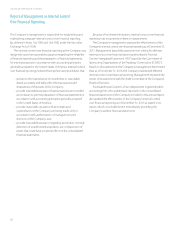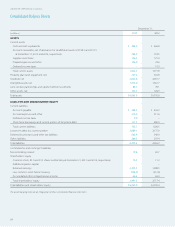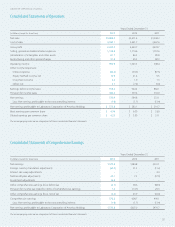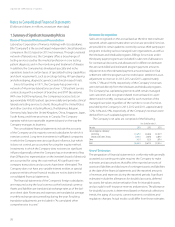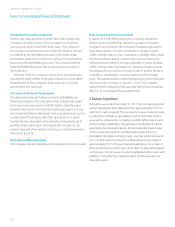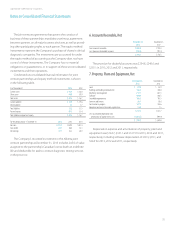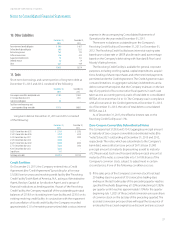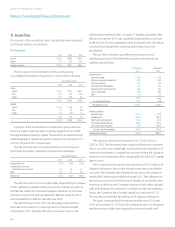LabCorp 2013 Annual Report Download - page 34
Download and view the complete annual report
Please find page 34 of the 2013 LabCorp annual report below. You can navigate through the pages in the report by either clicking on the pages listed below, or by using the keyword search tool below to find specific information within the annual report.
30
LABORATORY CORPORATION OF AMERICA
Notes to Consolidated Financial Statements
Stock Compensation Plans
The Company measures stock compensation cost for all equity
awards at fair value on the date of grant and recognizes compen-
sation expense over the service period for awards expected to
vest. The fair value of restricted stock awards and performance
shares is determined based on the number of shares granted and
the quoted price of the Company’s common stock on the grant
date. Such value is recognized as expense over the service period,
net of estimated forfeitures. The estimation of equity awards that
will ultimately vest requires judgment and the Company considers
many factors when estimating expected forfeitures, including types
of awards, employee class, and historical experience. The cumulative
effect on current and prior periods of a change in the estimated
forfeiture rate is recognized as compensation cost in earnings in
the period of the revision. Actual results and future estimates may
differ substantially from the Company’s current estimates.
See Note 14 for assumptions used in calculating compensation
expense for the Company’s stock compensation plans.
Cash Equivalents
Cash and cash equivalents consist of highly liquid instruments,
such as commercial paper, time deposits, and other money market
instruments, which have original maturities of three months or less.
Inventories
Inventories, consisting primarily of purchased laboratory and client
supplies, are stated at the lower of cost (first-in, first-out) or market.
Property, Plant and Equipment
Property, plant and equipment are recorded at cost. The cost of
properties held under capital leases is equal to the lower of the net
present value of the minimum lease payments or the fair value of
the leased property at the inception of the lease. Depreciation and
amortization expense is computed on all classes of assets based
on their estimated useful lives, as indicated below, using the
straight-line method.
Years
Buildings and building improvements 10-35
Machinery and equipment 3-10
Furniture and fixtures 5-10
Software 3-10
Leasehold improvements and assets held under capital leases
are amortized over the shorter of their estimated useful lives or the
term of the related leases. Expenditures for repairs and maintenance
are charged to operations as incurred. Retirements, sales and other
disposals of assets are recorded by removing the cost and accumu-
lated depreciation from the related accounts with any resulting
gain or loss reflected in the consolidated statements of operations.
Capitalized Software Costs
The Company capitalizes purchased software which is ready for
service and capitalizes software development costs incurred on sig-
nificant projects starting from the time that the preliminary project
stage is completed and the Company commits to funding a project
until the project is substantially complete and the software is ready
for its intended use. Capitalized costs include direct material and
service costs and payroll and payroll-related costs. Research and
development costs and other computer software maintenance
costs related to software development are expensed as incurred.
Capitalized software costs are amortized using the straight-line
method over the estimated useful life of the underlying system,
generally five years.
Long-Lived Assets
The Company assesses goodwill and indefinite lived intangibles
for impairment at least annually and more frequently if triggering
events occur. The timing of the Company’s annual impairment
testing is the end of the fiscal year. In accordance with the Financial
Accounting Standards Board (“FASB”) updates to their authoritative
guidance regarding goodwill and indefinite-lived intangible asset
impairment testing, an entity is allowed to first assess qualitative
factors as a basis for determining whether it is necessary to perform
quantitative impairment testing. If an entity determines that it is
not more likely than not that the estimated fair value of an asset is
less than its carrying value, then no further testing is required.
Otherwise, impairment testing must be performed in accordance
with the original accounting standards. The updated FASB guidance
also allows an entity to bypass the qualitative assessment for any
reporting unit in its goodwill assessment and proceed directly to
performing the first step of the two-step assessment. Similarly, a
Company can proceed directly to a quantitative assessment in
the case of impairment testing for indefinite-lived intangible assets
as well. In 2013 and 2012, the Company elected to bypass the
purely qualitative assessments for its goodwill and indefinite-lived
intangible assets and proceed to quantitative assessments utilizing
methodologies as described in the following paragraphs.




